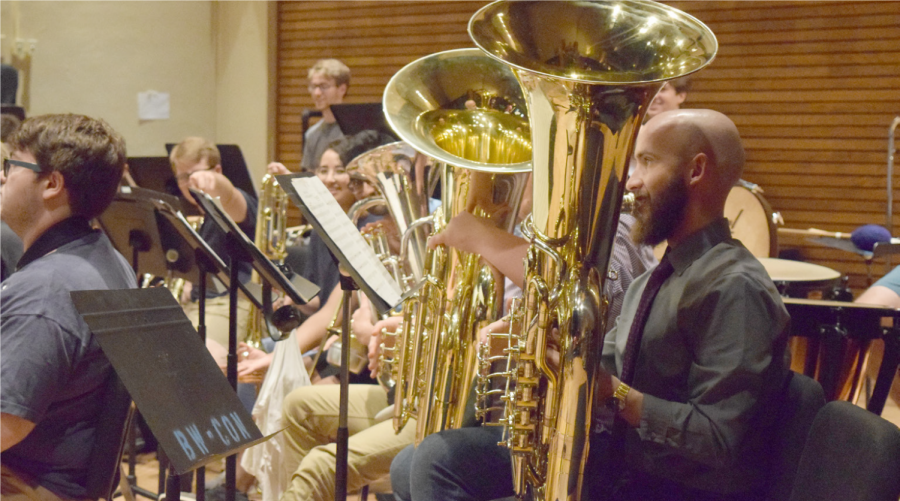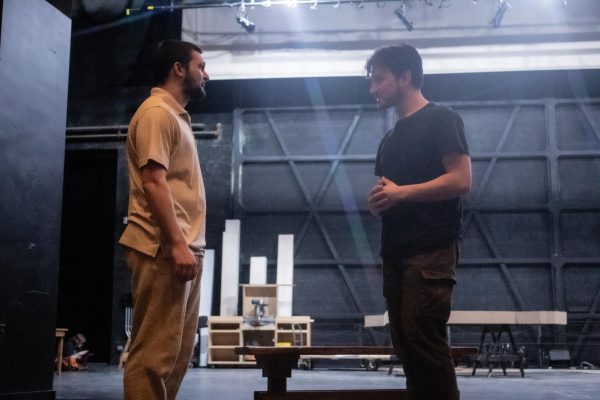Concert aims to ‘take listener on a journey’
The Symphonic Wind Ensemble is the premier winds/brass/percussion group at Baldwin Wallace University. Their next concert is set for Oct. 5.
On October 5, Baldwin Wallace University’s Symphonic Wind Ensemble will present “For a Future to Be Possible,” a concert that, according to Dr. Brendan Caldwell, Director of Wind Ensembles at Baldwin Wallace Conservatory, aims move listeners’ bodies, minds, and hearts.
The concert is free to attend and will be held in Gamble Auditorium at 7 p.m. Its program features three pieces: Profanation by Leonard Bernstein, Theme and Variations, Op. 43a by Arnold Schoenberg, and Give Us This Day by David Maslanka.
The Symphonic Wind Ensemble, said Caldwell, is BW’s premier winds/brass/percussion group. It is an auditioned group composed mostly of music students in their junior and senior years, he said. Destinee Siebe ‘19, Administrative Assistant for BW Wind Ensembles as well as a bassoonist in the Symphonic Wind Ensemble, said the group also includes several freshmen this year.
“We have a lot of first year students who auditioned and were accepted into the ensemble,” Siebe said. “Having a lot of new faces and new energy has been a lot of fun. Learning more about how to play together as one ensemble with new people is a really cool experience.”
The ensemble began practicing at the very start of the school year for the performance on October 5, said Caldwell, and has been “practicing really hard and really growing as artists to be able to pull this level of repertoire off.”
The chosen pieces create an arc for the concert, said Caldwell.
“They demand three very different things from the ensemble and from the audience,” he said. “Profanation is a piece that demands a lot physically of the students. It’s hard in its physicality. The second piece is really hard intellectually for the students and for the audience. And the third part challenges them in their heart. So it’s body, mind, heart.”
The opening piece of the concert will be Bernstein’s Profanation.
“Leonard Bernstein is the preeminent American composer and conductor of the 20th century, and this year, 2018, marks his 100th birthday,” said Caldwell, “So pretty much every ensemble is doing a Bernstein tribute.”
The piece also demands a lot of physical work from musicians, he said.
“It’s the first movement from his first symphony, and it’s very, very complex,” said Caldwell. “There’s 220 meter changes in a piece that lasts 7 minutes.”
The second piece, Schoenberg’s Theme and Variations, Op. 43a, is intellectually demanding, Caldwell said. It is one of the most difficult pieces he has done with the wind ensembles at BW.
“This piece is really hard,” said Caldwell, “It’s an immense challenge for the group, but they are stepping up to it in a really beautiful way.”
The third piece, Give Us This Day by David Maslanka, is a short symphony. According to its composer’s program notes, it was inspired by a book by Buddhist monk Thich Nhat Hanh that focused on intense, personal mindfulness as key to world peace. Caldwell says he entitled the concert “For a Future to Be Possible” after this book.
While rehearsing the piece with the ensemble, Caldwell said, he connected its progression with literary theorist Joseph Campbell’s “hero’s journey,” a story template found throughout the world.
“I overlaid the hero’s journey into this,” said Caldwell, “so that while rehearsing it, we’re feeling like this move into mindfulness is the same thing as the hero’s journey, which is the transcendence of fear into love.”
Siebe recounted one early audience reaction to hearing rehearsals for the Schoenberg piece.
“There was this little kid, maybe like two or three years old, out in the lobby of Gamble with their parent or grandparent,” said Siebe, “and this kid was just [standing] mouth agape, [saying], ‘This is the coolest thing I’ve ever heard!’”
Siebe hopes the concert’s audience will all find that sort of wonder in its music.
“I am always trying to take the listener on a journey,” Caldwell said. “By exploring the physical, intellectual, and spiritual, I’m trying to touch on each of the three human domains to make sure that no matter what the learning type is, no matter what the listening preference is, there’s something in this for everybody.”
The Exponent is looking for financial contributions to support our staff and our newsroom in producing high-quality, well-reported and accurate journalism. Thank you for taking the time to consider supporting our student journalists.













































